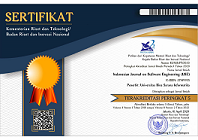TIMATCHER - Platform Pembagian Kelompok Ideal Menggunakan Parameter Softskill Dan Hardskill Berbasis Website
Abstract
Abstrak
Dewasa ini, kebutuhan manusia akan teknologi untuk meringankan pekerjaan semakin bertambah karena dengan semakin berkembangnya teknologi, maka akan mempermudah segala aktivitas kehidupan manusia salah satunya dalam pembagian kelompok. Pembagian kelompok selama ini dilakukan dilakukan secara acak, mandiri, dan dibagi berdasar nomor urut yang tidak mempertimbangkan parameter apapun sehingga menimbulkan kesenjangan, yaitu kemampuan kelompok satu dengan yang lain berbeda karena terdapat kemungkinan adanya kelompok super power yang berisi orang-orang paling pintar dalam kelas. Pembagian kelompok akan lebih efektif dan efisien dengan memaksimalkan penggunaan teknologi, yaitu melalui pemanfaatan sistem pembagian kelompok yang adil secara otomatis bernama TiMatcher dengan soft skill dan hardskill sebagai parameternya. Parameter soft skill diambil dari hasil tes MBTI dari setiap siswa/mahasiswa. Dari tes tersebut, didapatkan kode atau kersey yang digunakan sebagai dasar pembagian. Parameter hard skill ditentukan melalui hasil inputan tes hard skill yang telah dilakukan oleh siswa/mahasiswa. Tes hard skill tersebut dibuat oleh dosen/guru yang berisikan materi terkait. Dengan adanya TiMatcher, dosen dan mahasiswa dapat lebih dimudahkan dalam urusan pembagian kelompok ideal melalui pemanfaatan teknologi dengan sistem parameter hard skill dan soft skill. Prosentase hasil nilai fungsionalitas aplikasi TiMatcher sebesar 100% sesuai dengan kebutuhan user. Serta nilai keseluruhan aplikasi didapatkan rata-rata 73 dari range 0-100. Hal ini menunjukkan TiMatcher dapat melakukan pembagian kelompok lebih merata sehingga dapat mengurangi permasalahan kesenjangan pada kelompok.
Kata kunci: Pembagian kelompok, teknologi web, soft skill, hard skill
Abstract
Today, the human need for technology to relieve work is increasing because with the development of technology, it will facilitate all activities of human life, one of which is in the division of groups. Group division has been done randomly, independently, and divided based on sequence numbers that do not consider any parameters so as to cause gaps, namely the ability of groups with each other is different because there is a possibility of a super power group containing the smartest people in the class. Group division will be more effective and efficient by maximizing the use of technology, namely through the use of a fair group division system automatically called TiMatcher with soft skill and hard skill as its parameters. Soft skill parameter is taken from the MBTI test results of each students/college students. From the test, a code or kersey is obtained that is used as the basis for division. Hard skill parameter is determined through the results of input of hard skill tests that have been conducted by students/college students. The hard skill test is made by the lecturer/teacher which contains related materials. With TiMatcher, lecturers and students can be further facilitated in the affairs of ideal group division through the use of technology with hard skill and soft skill parameter systems. The percentage of the TiMatcher application functionality value is 100% according to user needs. And the overall value of the application obtained an average of 73 from the range 0-100. This shows that TiMatcher can divide groups more evenly so that it can reduce the problem of inequality in groups.
Keywords: Group division, web technology, soft skill, hard skill
Full Text:
PDFReferences
-, S., Dewi, W., Zulaikha, S., -, N., & Soraya, E. (2020). Model Pengembangan Kompetensi Sosial dan Kepribadian Guru Berbasis Myers Briggs Type Indicator/MBTI berbasis Tekonologi Informasi. International Journal of Psychosocial Rehabilitation, 24(03). https://doi.org/10.37200/ijpr/v24i3/pr200954
Dalton, J. (2019). Sprint Planning. In Great Big Agile. https://doi.org/10.1007/978-1-4842-4206-3_59
Fan, X. (2019). Orchestrating agile sprint reviews in undergraduate capstone projects. Proceedings - Frontiers in Education Conference, FIE, 2018-October. https://doi.org/10.1109/FIE.2018.8658435
Honggara, E. S., Purwanto, D. D., & Junaedi, H. (2021). Membangun Sistem POS Supermarket Dengan Tim tanpa Pengalaman Dalam Metodologi SCRUM. Journal of Information System,Graphics, Hospitality and Technology, 3(02). https://doi.org/10.37823/insight.v3i02.171
Hontong, F., Lumi, D. R. N., & Maragani, M. H. (2020). Soft Skill Guru dalam Mata Pelajaran Seni Budaya di SMP Garuda Manado. Clef : Jurnal Musik Dan Pendidikan Musik. https://doi.org/10.51667/cjmpm.v1i2.345
Hutauruk, M. K. (2019). UML Diagram : Use Case Diagram. In BINUS University.
Junaedi L. (2022). User persona: Pengertian, tujuan, cara membuat, dan 3 contohnya. Ekrut Media. https://www.ekrut.com/media/user-persona-adalah
Kamaludin, K. (2020). Analisis Hard Skill Sebagai Pondasi Bisnis Bagi Pelaku Usaha Mikro. Syntax Literate ; Jurnal Ilmiah Indonesia, 5(5). https://doi.org/10.36418/syntax-literate.v5i5.1159
Labib, Moch. A. M., & Wibawa, B. M. (2019). Analisis Peta Kompetitor Industri Mobile Payment di Indonesia. Jurnal Sains Dan Seni ITS, 8(1). https://doi.org/10.12962/j23373520.v8i1.41789
Lumbarina, L. (2018). Peningkatan Kemampuan Bahasa Indonesia Mendeskripsikan Tempat Sesuai Denah melalui Metode Kerja Kelompok Siswa Kelas IV SD Negeri 011 Pulau Kedundung. GERAM, 6(2). https://doi.org/10.25299/geram.2018.vol6(2).2055
Nurhakim, A. S., Suparno, O., & Nurrochmat, D. R. (2018). Pengembangan Model Bisnis Dan Strategi Pelayanan Kesehatan XYZ. Jurnal Aplikasi Bisnis Dan Manajemen. https://doi.org/10.17358/jabm.4.2.251
Nurzaman, F. (2020). Pengembangan Sistem Otomatisasi Tagihan Menggunakan Metode Agile Software Development. Jurnal IKRA - ITH Informatika, 4(1).
Nyerges, T. (2017a). Conceptual Data Models. Geographic Information Science & Technology Body of Knowledge, 2017(Q1). https://doi.org/10.22224/gistbok/2017.1.3
Nyerges, T. (2017b). Physical Data Models. Geographic Information Science & Technology Body of Knowledge, Q1. https://doi.org/10.22224/gistbok/2017.1.1
Remta, D., & Buchalcevova, A. (2021). Product owner’s journey to safe®—role changes in scaled agile framework®. Information (Switzerland), 12(3). https://doi.org/10.3390/info12030107
Robbins, M., & Ross, C. (2020). Keirsey Temperament Sorter. Encyclopedia of Personality and Individual Differences, 2518–2521. https://doi.org/10.1007/978-3-319-24612-3_44
Sama, H., & Chandera, A. (2021). Perancangan Dan Pengembangan Online Shop Support System Berbasis Lean Canvas. Conference on Management, Business, Innovation, Education and Social Science, 1(1).
Schwaber, K., & Sutherland, J. (2017). The Scrum Guide: The Definitive The Rules of the Game. Scrum.Org and ScrumInc, November.
Shastri, Y., Hoda, R., & Amor, R. (2021). Spearheading agile: the role of the scrum master in agile projects. Empirical Software Engineering, 26(1). https://doi.org/10.1007/s10664-020-09899-4
Suhari Camara M, A., Aelani, K., & Dwi Juniar S, F. (2021). Pengujian Kualitas Website menggunakan Metode McCall Software Quality. Journal of Information Technology, 3(1). https://doi.org/10.47292/joint.v3i1.43
Sulianta, F. (2017). Teknik Perancangan Arsitektur Sistem Informasi. In Teknik Perancangan Arsitektur Sistem Informasi.
Werewka, J., & Spiechowicz, A. (2017). Enterprise architecture approach to SCRUM processes, sprint retrospective example. Proceedings of the 2017 Federated Conference on Computer Science and Information Systems, FedCSIS 2017. https://doi.org/10.15439/2017F96
Wibowo, A. (2020). SISTEM MONITORING SKENARIO TESTING PADA SISTEM IFINANCING STUDY KASUS PT. IMS. Jurnal Ilmu Teknik Dan Komputer, 4(1). https://doi.org/10.22441/jitkom.2020.v4.i1.001
DOI: https://doi.org/10.31294/ijse.v8i1.11783

This work is licensed under a Creative Commons Attribution-NonCommercial-ShareAlike 4.0 International License.
ISSN : 2714-9935


Published by LPPM Universitas Bina Sarana Informatika
Jl. Kramat Raya No.98, Kwitang, Kec. Senen, Kota Jakarta Pusat, DKI Jakarta 10450
This work is licensed under a Creative Commons Attribution-ShareAlike 4.0 International License









